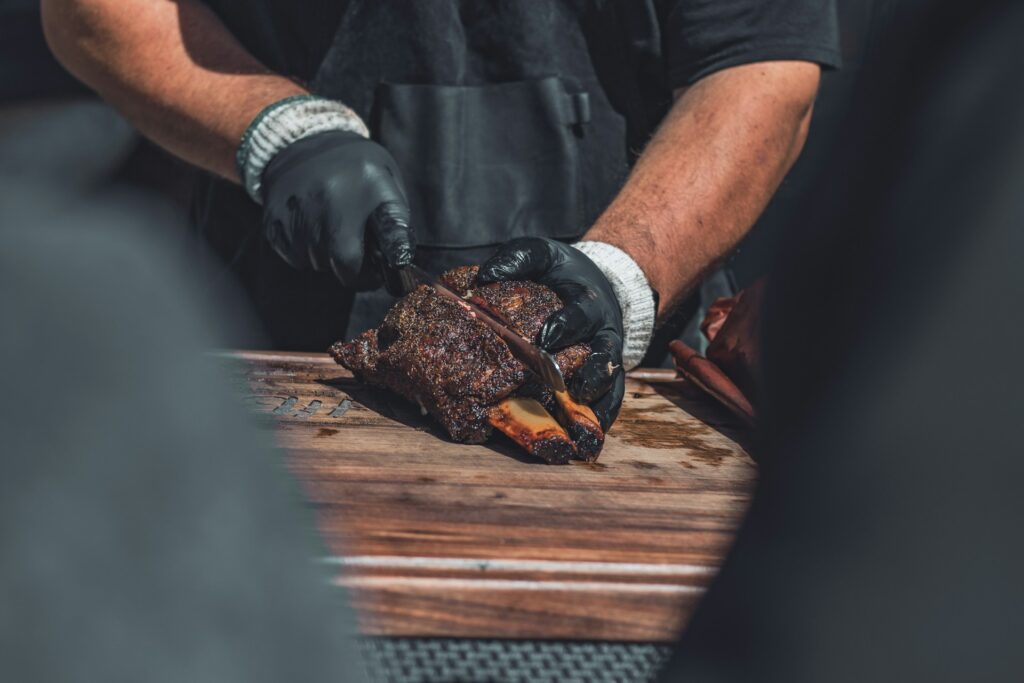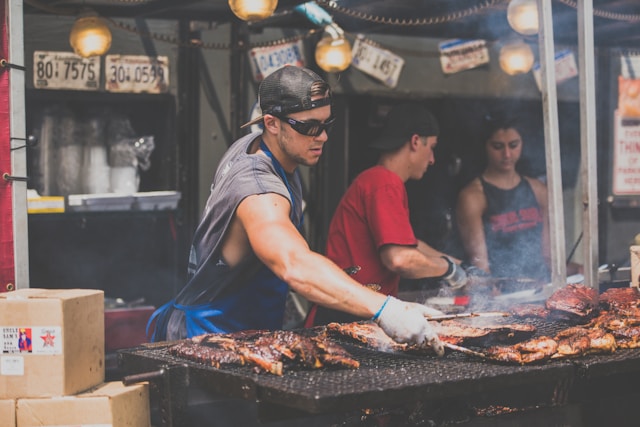BBQ Gloves Showdown: A Comparison of Materials, Durability, and Price Points
Whether you’re a seasoned pitmaster or a casual weekend griller, having the right tools can make all the difference in your cooking experience, and few tools are as essential as a good pair of BBQ gloves.
Designed to protect your hands from intense heat while offering the dexterity needed to handle food and utensils, the right gloves can elevate your grilling game to new heights.
Choosing the best BBQ gloves involves more than just picking up the first pair you see on the shelf. It requires understanding the unique properties of different materials—such as silicone, leather, and fabric—each offering distinct advantages in terms of heat resistance, flexibility, and overall durability.
In addition to these functional aspects, considering the price points and getting the best value for your money are crucial factors.
Overview of BBQ Glove Materials
When selecting BBQ gloves, the choice of material is of great importance as it directly influences the gloves’ heat resistance, durability, and overall comfort.
Here’s a breakdown of the most common materials used in BBQ gloves: silicone, leather, and fabric, each offering unique benefits depending on your grilling needs.
Silicone Gloves
Properties: Silicone gloves are celebrated for their excellent heat resistance and waterproof capabilities. The material is inherently non-slip, which helps in achieving a firm grip on wet or greasy items. Silicone is also hypoallergenic and resistant to staining and odors, making it a hygienic choice for handling food.
Typical Uses: These gloves are ideal for handling hot foods directly, such as turning ribs on the grill or pulling pork. Their waterproof nature makes them easy to clean under running water or in the dishwasher, ensuring they are ready for the next use without much fuss.

Leather Gloves
Properties: Leather is highly regarded for its exceptional durability and protection. It offers superior resistance to punctures and cuts, which is crucial when working with sharp utensils or rough, hot equipment like grill grates and smoker boxes.
Typical Uses: Leather gloves are best suited for handling very hot equipment and performing tasks that require a high level of heat protection but less dexterity, such as moving hot grates, arranging logs in a smoker, or managing coals. The robust nature of leather makes these gloves a favorite among those who need long-lasting protection.
You can check out these leather gloves that I found on Amazon.
Fabric Gloves
Properties: Many modern fabric gloves are made from advanced synthetic materials like aramid fibers, which provide excellent heat resistance and are often used in aerospace and military applications. These gloves can withstand extreme temperatures and are usually lined with cotton or a similar material to enhance comfort.
Special Coatings: Some fabric gloves feature silicone strips or other coatings to improve grip and heat resistance. This dual-material approach combines the flexibility and comfort of fabric with the heat-resistant benefits of silicone.
Typical Uses: Fabric gloves are incredibly versatile and suitable for a range of tasks, from adjusting vents on a grill to handling hot pans in a kitchen setting. They strike a balance between dexterity and protection, making them an excellent choice for precise tasks that require handling hot objects directly.
These fabric gloves are the ones that I like to use. The price is pretty nice too. Check them out on Amazon.
Comparing Heat Resistance and Suitability for Different Grilling Tasks
When choosing BBQ gloves, it’s crucial to consider how well they can withstand heat and their suitability for various grilling tasks. Below, we’ll compare the heat resistance of silicone, leather, and fabric gloves and discuss specific grilling scenarios where each type excels.
Heat Resistance Comparison:
Silicone Gloves: Typically, silicone gloves can withstand temperatures up to 450°F to 500°F. This makes them excellent for handling hot food and utensils but less ideal for extremely high-heat tasks like directly handling coals or wood embers.
Leather Gloves: Leather gloves are adept at handling higher temperatures, often up to 600°F, depending on their thickness and quality. They provide excellent protection for tasks involving direct contact with flames or hot metal, such as rearranging logs in a fire or lifting a hot grill grate.
Fabric Gloves (Aramid Fibers): Gloves made from aramid fibers are among the best for high-heat resistance, capable of handling temperatures well beyond 932°F. This extreme heat resistance makes them perfect for the highest-temperature grilling tasks, including managing coals and working with wood-fired ovens.
Task Suitability:
Silicone Gloves: Ideal for general grilling tasks that require good dexterity and direct food contact, such as turning meats on the grill or handling hot skewers. Their water-resistant nature also makes them useful for cleaning tasks post-grilling, as they can be washed easily.

Leather Gloves: Best suited for handling rough and hot equipment. Their rugged construction protects against sharp edges and hot surfaces, making them ideal for tasks like moving grill grates or handling logs in smokers. Leather gloves are less flexible, however, which can reduce dexterity for more delicate tasks.
Fabric Gloves (Aramid Fibers): With their superior heat resistance and flexibility, fabric gloves are excellent for a wide range of tasks. They are particularly useful for tasks requiring both heat protection and fine motor skills, such as adjusting vents, handling tools, or even carving meat right off the grill.

Durability and Maintenance of BBQ Gloves
The longevity and performance of BBQ gloves largely depend on their material composition and how well they are maintained. Understanding the durability of each type of glove and how to care for them can ensure that your BBQ gloves remain in good condition for many grilling seasons.
Durability of BBQ Gloves:
Silicone Gloves: Silicone is highly durable and resistant to wear and tear from regular use. These gloves do not absorb smells or fluids, which helps them resist degradation over time. However, they can be susceptible to punctures and tears when exposed to sharp objects or extremely high temperatures.
Leather Gloves: Leather is known for its exceptional toughness and ability to withstand harsh conditions. With proper care, leather gloves can last for several years. The natural material is prone to drying out and cracking if not treated regularly with leather conditioners or oils.
Fabric Gloves (Aramid Fibers): Aramid fiber gloves are incredibly durable in terms of heat resistance and mechanical wear. They can withstand repeated exposure to high temperatures without melting or catching fire. However, they may lose their insulating properties if they become soiled or are washed improperly.
Maintenance Tips:
Silicone Gloves:
- Clean regularly with soap and water to remove grease and food residues.
- Silicone gloves are generally dishwasher-safe, making them easy to sanitize and prepare for the next use.
- Store away from sharp objects to avoid punctures or tears.
Leather Gloves:
- Wipe down with a damp cloth after use to remove grease and soot.
- Periodically treat with leather conditioner to keep the material supple and prevent cracking.
- Avoid exposing leather gloves to excessive moisture, as this can lead to mildew or hardening of the leather once dried.
Fabric Gloves (Aramid Fibers):
- Machine wash on a gentle cycle with mild detergent; it’s crucial to follow the manufacturer’s washing instructions to maintain their protective qualities.
- Allow to air dry completely before storage to prevent mildew or fabric degradation.
- Inspect regularly for signs of wear or damage, especially if used frequently for high-heat tasks.
- Proper care and maintenance not only extend the life of BBQ gloves but also ensure they continue to provide maximum protection and performance during grilling.
Price Points and Value for Money
The materials used, the level of craftsmanship, and additional features like heat resistance or special coatings all affect the price range of BBQ gloves. Understanding these factors can help you make a cost-effective choice that doesn’t sacrifice quality or safety.
Overview of Price Ranges:
Silicone Gloves: These are generally the most affordable option, with prices ranging from $10 to $25. Silicone gloves are cost-effective due to their versatility and ease of maintenance. They offer good value for money, especially for casual grillers or those who prefer straightforward, functional tools.
Leather Gloves: Leather gloves tend to be mid-range in price, typically between $20 and $50. The price can vary based on the quality of the leather and the construction of the glove. High-quality leather that offers better heat protection and durability will be at the higher end of this range.
Fabric Gloves (Aramid Fibers): These are usually the most expensive, ranging from $30 to over $60, due to their advanced material properties and superior heat resistance. Professional chefs and serious barbecue enthusiasts who require the highest level of protection frequently use them.
Value for Money:
Silicone Gloves: Excellent for those who need reliable, easy-to-clean gloves for handling food and performing general grilling tasks. They provide good heat resistance and flexibility at a lower cost, making them a great entry-level choice.
Leather Gloves: Ideal for those who engage in heavy-duty grilling and need robust protection. The initial investment is higher, but the durability of leather can offer better long-term value, particularly if the gloves are properly cared for.
Fabric Gloves (Aramid Fibers): Best for high-heat grilling situations and frequent use. While they are more expensive, their ability to withstand extreme temperatures and maintain dexterity makes them a worthwhile investment for serious grillers.
Recommendations for Best Buys and Budget Options:
For budget-conscious buyers, basic silicone gloves can provide adequate protection for most typical backyard grilling tasks without a significant financial outlay.
Those looking for a balance between cost and performance might consider mid-range leather gloves, which offer better protection and longevity.
For those who frequently grill at high temperatures or professionally, investing in high-quality fabric gloves made from aramid fibers can be cost-effective in the long run due to their superior durability and heat resistance.
Conclusion
Choosing the right BBQ gloves is essential for enhancing your grilling experience, ensuring safety, and maintaining efficiency. Whether you’re handling hot coals, flipping burgers, or moving a grill grate, the type of gloves you wear can significantly influence your ability to perform these tasks safely and effectively.
By understanding the different materials available—silicone, leather, and fabric—and their specific properties, you can make an informed decision that best suits your grilling style and needs. Proper maintenance and recognizing the value each type offers will also help you get the most out of your investment.
Remember, the best BBQ gloves are the ones that fit not only your hands but also your cooking style and safety requirements.
Key Takeaways:
- Material Matters: Choose silicone gloves for ease of use and cleaning, leather for durability and handling high heat, and fabric gloves for the highest heat resistance and flexibility.
- Heat Resistance: Silicone is suitable for moderate heat, leather for higher heat, and aramid fibers for extreme conditions.
- Durability and Care: Silicone is low-maintenance but less durable against sharp objects; leather requires regular conditioning; and fabric gloves need proper washing and care to maintain their protective qualities.
- Price vs. Value: Silicone gloves are cost-effective for basic needs; leather gloves are a good middle ground for more serious grillers; and aramid fiber gloves offer professional-grade protection and are worth the investment for frequent high-temperature grilling.
- Invest Wisely: Consider how often you grill and what tasks you perform most frequently to choose gloves that provide the best return on investment in terms of durability, protection, and price.





Comments are closed.